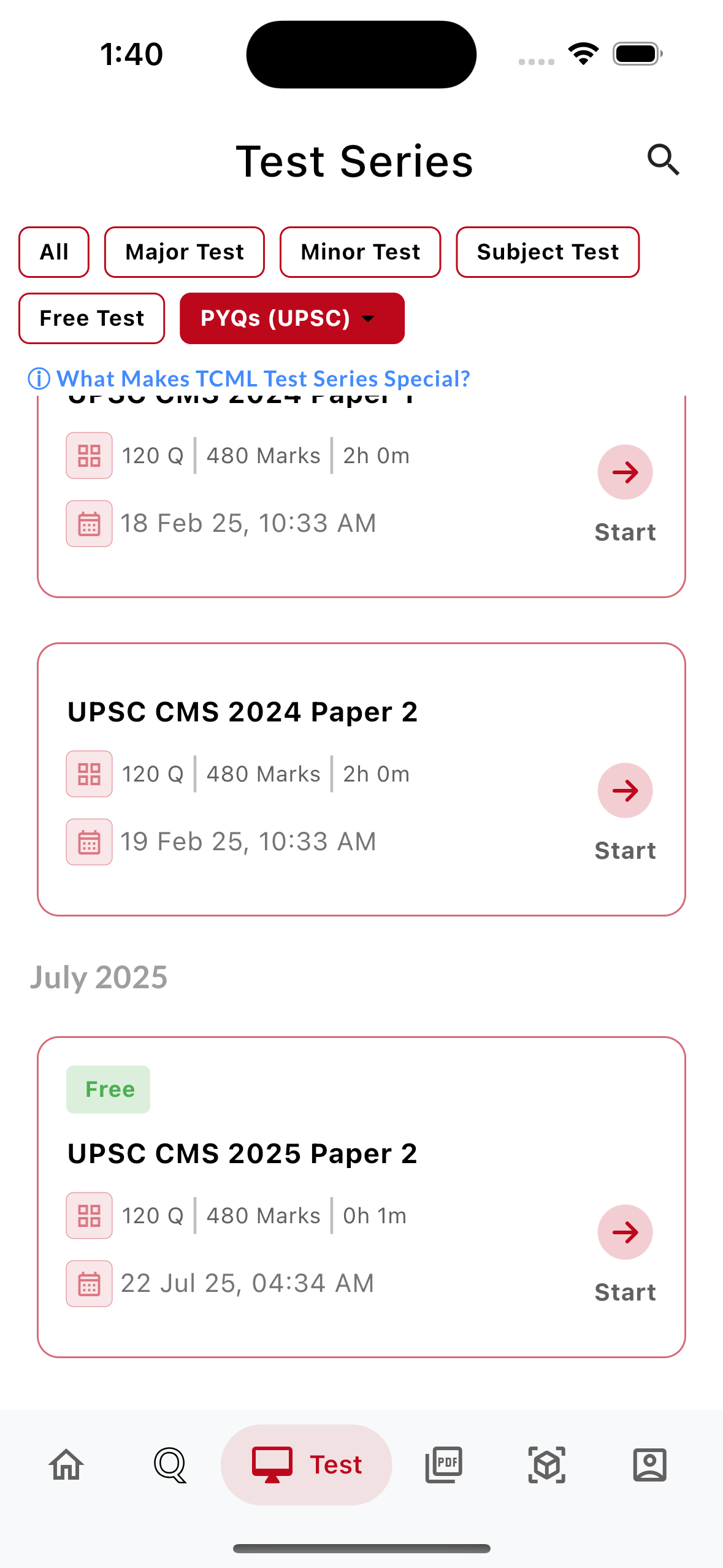UPSC CMS 2025 Answer Key with Explanations
The UPSC Combined Medical Services (CMS) 2025 examination was successfully conducted on July 20, 2025. TCML (The Charsi of Medical Literature) has meticulously prepared a comprehensive answer key with expert-reviewed explanations for all questions.
This detailed UPSC CMS 2025 answer key provides in-depth explanations to help medical students and aspirants understand the concepts tested. To access the complete set of solutions, download our free TCML app – your trusted companion for medical entrance exam preparation.
This resource is invaluable for medical students preparing for NEET PG, UPSC CMS, AIIMS INI-CET, and other competitive medical examinations. Our expert faculty has ensured accuracy and clarity in every explanation.
Download TCML App – Free Access
Get instant access to complete UPSC medical paper solutions and comprehensive study materials through the TCML app:
How to Access UPSC CMS Answer Key in TCML App
Follow these simple steps to access the complete UPSC CMS answer key with detailed explanations:
Login to TCML App
Download and install the TCML app from your device’s app store, then log in with your credentials to access all study materials.

Navigate to Test Series
Tap on the “Test” tab at the bottom of your screen to access the Test Series section with exam materials and previous year questions.

Select UPSC CMS Papers
Access UPSC CMS specific content:
- Look for the “PYQs” dropdown menu
- Select “UPSC CMS” from the available options
- Browse through all UPSC CMS papers with detailed solutions

What You’ll Find in TCML App
Expert-reviewed solutions for UPSC CMS 2024 & 2025 papers with detailed explanations
Many papers available for free study with no hidden charges
NEET PG, INI-CET, FMGE, and other medical entrance exam materials
Study anywhere, anytime with our responsive mobile interface
Sample Questions from UPSC CMS 2025
Here are sample questions with detailed explanations. Access the complete free answer key with explanations in the TCML app:
Question 1: Rashtriya Bal Swasthya Karyakram (RBSK)
I. Hypothyroidism
II. Vitamin A deficiency
III. Anemia
IV. Vitamin D deficiency
Select the correct answer using the code given below:
View Detailed Explanation
Under RBSK (Rashtriya Bal Swasthya Karyakram), the deficiencies included are I, II, and IV (Hypothyroidism, Vitamin A deficiency, and Vitamin D deficiency), making option B correct.
RBSK Program Overview:
- Launched in 2013 for child health screening
- Covers 0-18 years age group
- Focuses on 4 D’s: Defects, Diseases, Deficiencies, Development delays
Deficiencies Covered by RBSK:
- Hypothyroidism: ✓ Included – Congenital hypothyroidism screening, impacts growth and development
- Vitamin A Deficiency: ✓ Included – Major cause of childhood blindness, impacts immunity
- Anemia: ✗ Not specifically listed as deficiency under RBSK
- Vitamin D Deficiency: ✓ Included – Causes rickets and bone deformities
Question 2: Pediatric Hyperkalemia Management
I. Intravenous calcium (gluconate or chloride) is given to enhance cellular uptake of potassium
II. Beta adrenergic agonists (salbutamol or terbutaline) are used to stabilize myocardial cell membrane
III. Regular insulin and glucose given intravenously enhance cellular uptake of potassium
IV. Sodium polystyrene sulfonate enhances total body potassium elimination
Select the answer using the code given below:
View Detailed Explanation
The correct statements regarding pediatric hyperkalemia management are III and IV, making option D correct.
Analysis of Each Statement:
- Statement I – Incorrect: IV calcium stabilizes cardiac membrane but doesn’t enhance K⁺ uptake
- Statement II – Incorrect: Beta-agonists enhance cellular K⁺ uptake, calcium stabilizes membrane
- Statement III – Correct: Insulin + glucose activates Na⁺-K⁺-ATPase pump, driving K⁺ into cells
- Statement IV – Correct: Sodium polystyrene sulfonate removes K⁺ via GI tract
Treatment Algorithm:
- Membrane stabilization: IV calcium gluconate
- Cellular shift: Insulin+glucose, beta-agonists
- K⁺ elimination: Exchange resins, dialysis
Question 3: Developmental Milestones
View Detailed Explanation
A child who can make a tower of 3 blocks, runs, copies mother while sweeping, and has 8-10 words has a developmental age of 18 months.
Milestone Analysis:
- Fine Motor: 3-block tower = 18 months
- Gross Motor: Running (stiffly) = 18 months
- Social: Imitating household activities = 18 months
- Language: 8-10 words = 18 months (typical range 10-20 words)
18-Month Milestones:
- Builds tower of 3-4 blocks
- Runs stiffly with frequent falls
- Imitates household activities
- Has vocabulary of 10-20 words
- Follows simple commands
Why Choose TCML for Medical Exam Preparation?
- Expert-Reviewed Content: All solutions verified by experienced medical faculty
- Comprehensive Coverage: Complete answer keys for NEET PG, UPSC CMS, AIIMS INI-CET
- Free Access: No hidden charges – completely free through our app
- Detailed Explanations: In-depth analysis helping you understand concepts
- Regular Updates: Latest exam patterns and question trends
- Mobile-Friendly: Study anywhere, anytime with our responsive platform
This answer key is created by TCML (The Charsi of Medical Literature) for educational purposes and is not affiliated with UPSC.

